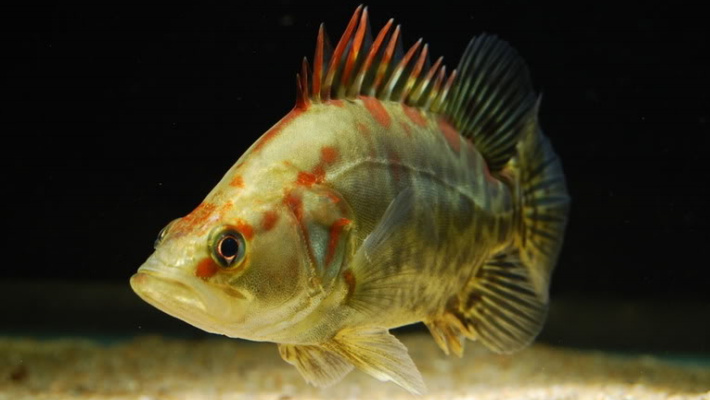|
Black color
occurs in coloration of many freshwater fish beening relatively constant throughout
the year and cryptic (in such, for example, bottom dwelling fish as wels, Silurus glanis). In this paper, we will consider those frequent cases
when chiefly males of freshwater fish acquire black coloration in the
reproductive period (nuptial melanization).
For desalinated
areas and rivers of the Ponto-Caspian basin, five species of gobiid fish with
nuptial melanization of body are most typical and abundant. Round goby, Neogobius melanostomus, monkey goby, N. fluviatilis, ratan goby, N. ratan, black goby, Gobius niger, and racer goby, Mesogobius gymnotrachelus, are among
them. Gobies are marine origin, but the foregoing species (as well as many
amelanistic species) inhabit desalinated areas and readily migrate into rivers
of the Ponto-Caspian basin where successfully breed (Pinchuk et al., 1985;
Romanesku, 2012). Some other euhaline gobies develop black nuptial coloration,
such as giant goby, Gobius cobitis),
but they avoid oligohaline bays and fresh waters.
In the
reproductive period, gobies acquire conspicuous black coloration practically of
the whole body using such an appearance, on the one hand, to repel rivals (in
this case, black coloration is called threat, or antaposematic) and, on the
other hand, to attract females (Trifonov, 1955; Yankovsky, 1966). Some gobies
acquire color rims on the edge of both dorsal fins, pair pectoral and anal
fins: white in N. melanostomus,
yellow in M. gymnotrachelus and
orange in N. fluviatilis. In accordance with the accepted terminology (Trifonov, 1955; Yankovsky, 1966), these
conspicuous color signs are called gamosematic, bacause these signs appear in
males when they prepare the nests, indicating in this way on their readyness to
breed, and disappear in males when they begin to protect the nests with laying
eggs.
Spawning
and nest guarding in N. melanostomus are
well documented (Meunier et al., 2009).
In general,
round goby, N. melanostomus, and other gobies are rather visually guided
fish with the specialized chemoreceptory channel. N. melanostomus respond poorly to the odors of lake whitefish (Coregonus) tissues, crushed dreissenids
and fish eggs (Sreedharan
et al., 2009; Yavno & Corkum, 2011). At least Sreedharan et al. (2009) do
not recommend to use food-baited traps to control the spread of these fish.
According to Rollo et al. (2007), N. melanostomus have well developed vocalization and
are attracted by conspecific calls in both laboratory and field trials.
Nuptial
melanization is also found in such fish of the North American ichthyofauna as dirty
darter, Etheostoma olivaceum, Gila topminnow, Poeciliopsis
occidentalis, and Olympic mudminnow, Novumbra
hubsi (Kodric-Brown,
1998). Coloration of males in brook stickleback, Culaea
inconstans (Ward & McLennan, 2006), mosquitofish, Gambusia holbrooki (Horth, 2004) and
Amur sleeper, Percottus glehni (Tsepkin, 1977), are other examples
of nuptial melanization.
Interestingly,
in mosquitofish, G. holbrooki, black males have advantages and
disadvantages to more common silver rivals. On the one hand, largemouth bass, Micropterus salmoides, crayfish (Procambarus) and dragonfly larvae (Libellulidae) prefer, as natural predators, silver males (Horth, 2004), that is black
males are under less predation pressure. According to Taylor et al. (1996), on the
other hand, females of G. holbrooki prefer silver males and even can avoid
black males.
Basic References
Horth L.
2004. Predation and the
persistence of melanic male mosquitofish (Gambusia
holbrooki). Journal of Evolutionary Biology 17,
672-675
Kodric-Brown
A. 1998. Sexual
dichromatism and temporary color changes in the reproduction of fishes. American Zoologist 38, 70-81
Meunier B.,
Yavno S., Ahmed S., Corkum L.D. 2009. First documentation of spawning
and nest guarding in the laboratory by the invasive fish, the round goby (Neogobius melanostomus). Journal of Great Lakes Research 35,
608-612
Pinchuk
V.I., Smirnov A.I., Koval N.V., Shevchenko G.G. 1985. On the present
distribution of gobiid fish (Gobiidae, Pisces) in the Dnieper
river. Hydrobiological research of fresh waters. Naukova Dumka Publishers,
Kyiv, 121-130
Rollo A.,
Andraso G., Janssen J., Higgs D. 2007. Attraction and localization of round goby (Neogobius melanostomus) to conspecific
calls. Behaviour 144, 1-21
Romanesku
V.K. 2012. Gobies (Perciformes: Gobiidae) in water bodies
of the Republic
of Moldova. Modern problems of fisheries
management and ecology of the Azov-Black Sea region.VII International Conference: June
2012. Kerch, Ukraine, 171-174
Sreedharan G., Corkum L.D., Johnson T.B. 2009. Response of
the round goby, an invasive fish, to food odours. Verhandlungen des Internationalen Verein Limnologie 30, 1275-1278
Taylor S.A.,
Burt E., Hammond
G., Relyea K. 1996. Female mosquitofish (Gambusia affinis holbrooki)
prefer normally pigmented males to melanistic males. Journal of Comparative Psychology 110, 260-266
Trifonov G.P. 1955. Breeding biology of Azov gobies. Proceedings of the
Karadag Biological Station 13, 5-46
Tsepkin
E.A.1977. On the nuptial dress of male Percottus
glehni Dyb. Ichthyological Journal
17, 945-947
Ward J.L., McLennan D.A.
2006. Changes in agonistic, courtship and parental
displays of the male brook stickleback, Culaea
inconstans, across the breeding cycle. Behaviour
143, 33-56
Yankovsky B.A. 1966. On the breeding biology of some Azov gobies (Gobiidae). Hydrobiological Journal 2, 48-52
Yavno S.,
Corkum L.D. 2011. Round goby Neogobius
melanostomus attraction to conspecific and heterospecific egg odours. Journal of Fish Biology 78, 1944-1953
|








 SUBSCRIBE
SUBSCRIBE


